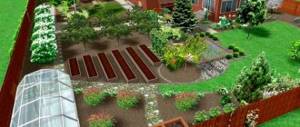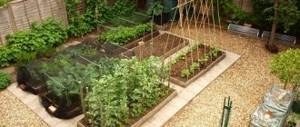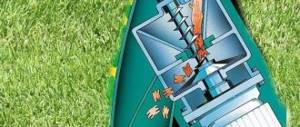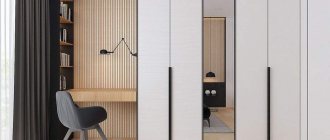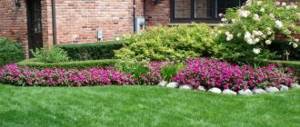No massive walls or fences!
The wall and fence physically limit the area. A high monolithic fence creates the effect of enclosure, and your already small courtyard looks like a closed box. Therefore, demolish all the fences. If you can’t do without a fence, then consider light openwork fences; in extreme cases, the same chain-link mesh will do. This grid can be decorated by planting climbing plants nearby.
What to do if a huge wall pushes into your property? For example, the wall of a country house, or a neighbor’s garage? Take some old mirrors and attach them to the wall. Now, instead of brick or gray plaster, you will contemplate the reflection of your garden in the mirrors!
What to consider when planning a site
At the very beginning, you should draw up a plan, develop a detailed project yourself or with the help of specialists. The bottom line is that the area of a small area should be used to the maximum. The land plot is divided into work areas and recreation areas. First, large structures are planned - a house, a garage, a bathhouse. After this, a space is selected for a vegetable garden, garden, flower garden, and paths running between them.
When planning, take into account the shape of the site:
- rectangular - the most comfortable, the house and recreation area here are located in the depths of the garden, in the far corner of the outbuildings, next to the vegetable garden;
- oval-elongated - the zoning here is more clear, decorative “hedges” are used for it, color zoning can be used, when brightly flowering plants of a warm color are planted along the short sides, small ones with cool-colored flowers are planted near the long sides;
- L-shaped - in a protruding “branch”, behind the house, there is a recreation area, outbuildings will be located in the far corner of the site, a vegetable garden is closer to the house.
Basic planning principles:
- house - it is better to place it on the opposite edge relative to the entrance to the site, then everything will fit as beautifully as possible;
- the main route is from the gate to the door of the house, it is done first;
- trees - excessively large ones should be discarded; a variety of conifers, apple trees and others provide a lot of shade, occupying useful space;
- large buildings - they should be planned at the bare minimum: if a gazebo, then a corner one, if a barn, then in the form of an extension to the house;
- lighting - all significant objects are illuminated: a gazebo, the entrance to the house, the main path, a decorative fountain or pond;
- beds with vegetables - placed around the perimeter of the dacha or all in one place, without disturbing the appearance;
- decorations - small figures of gnomes, forest dwellers, fairy tale heroes will decorate the space.
The house is placed, if possible, at the highest point of the site so that spring waters do not flood it. It is advisable that the windows of the kitchen, bedroom, and children's room face the south side.
Path to infinity...
Very often in our small garden plots we do not attach importance to garden paths, but in vain! After all, it can transform even the most meager space! But, there is one “BUT”! To do this, the path must be narrow and curved, even crooked.
This kind of winding path creates the impression of a long walk through the garden and visually continues your area. The path seems to run into the distance, expanding the space and giving it a certain mystery.
Create a path that leads “to nowhere,” such as an overgrown thicket of greenery. Then it will create the impression of a continuation of the garden.
Landscape design of a small plot - advice from professionals
Many people think that doing all the work is quite simple. However, this is not entirely true, because with a small area, all compositions in the garden should be made as compact as possible, combining them correctly with each other. Any mistake you make will be immediately noticeable. When you are about to start creating a design, you just need to follow a few important rules:
- Tall shrubs and trees cannot be planted. Is the plot size no more than 10 acres? In this case, tall plants are contraindicated for him. And all because as they grow older, they will fill the area, reducing the free space. To avoid this, be sure to plant low-growing tree types. Also, do not forget about compact planting - plant them in groups, not individually.
- A blank fence can also ruin the design. And all because it will create the impression of being in a closed box, which will not bring any comfort and coziness. It is best to use an openwork metal gate and fence, decorating them with flowering vines. This is what will significantly expand the site.
- It is best to remove bulky buildings from the site. Of course, in a dacha it’s quite difficult to do without them, but a huge building and a small garden do not correspond to each other. It is best to make buildings one-story, visually “airy” and compact. You can intelligently distribute them throughout the garden, decorating neat buildings with the help of shrubs and flowering plants.
In the photo - landscape design of the site, diynetwork.com
In the photo - landscape design of a small yard, landscapedgardensideas.landscapeideasanddesign.com
Photo - small backyard, smallbackyardlandscapingideas.com
In the photo - landscape design of a small area, admiralgreen.com
In the photo - landscape design of a small plot, natesgardencenter.com
A body of water – even the smallest one!
The surface of the water creates the same effect as a mirror; it reflects the blue of the sky and plays with natural colors. You can create a small decorative pond, a small fountain, or a stream running along the site.
If possible, there will also be a place for a decorative garden bridge, which until recently it would not even have occurred to you to build in your limited area!
Zoning
The first thing a summer resident should do is draw a diagram of the available land. The local landscape is divided into five zones:
- recreation;
- garden;
- garden;
- residential;
- economic
Depending on what you mainly plan to do at the dacha - gardening, gardening or just relaxing, a certain area is allocated for each zone. 55-75% of the territory is usually allocated for a garden, 15-20% for a recreation area, and a house with outbuildings will occupy up to 10% of the site.
Complete information about the site is the basis for successful zoning. If you plan to build an artesian well, a swimming pool, or a well, the groundwater level and the degree of slope are important.
Functional recreation area
When a private area is intended primarily for recreation, this place is arranged taking into account maximum convenience for vacationers. There will be a bathhouse with a small artificial pond, a rock garden with a gazebo, and a terrace with barbecue. All elements are located nearby or in three different places on the territory, interspersed with lush flower beds and alpine slides. Homemade decor from scrap materials will give you the opportunity to show your creativity by decorating the space. Swans made from old tires, palm trees made from plastic bottles, carved “wooden grandfathers” will give the dacha a unique, inimitable flavor; any means will be good.
Ergonomic location of outbuildings
Outbuildings are made as inconspicuous as possible, preferably in the most remote corners of the garden. They are decorated with “creeping” plants, positioned so that the buildings do not shade the beds or make the yard cramped. They are also used as protection from cold winds, so it is advisable to place them on the north or northwest side.
The norms of distances from various objects to the buildings of neighbors, their fences, are regulated by many norms and rules that must be followed in order to avoid fines and forced demolition.
Choosing trees for the garden, their location on the site
The trees chosen are not too large, not spreading, otherwise they will greatly shade the area. They are grouped in the center or along the perimeter of the site. With the help of trees, functional zones are separated and combined with shrubs. Among the fruit trees, low-growing apple trees, cherries, and pears are selected, and among the bushes, currants and gooseberries are selected. Decorative thujas, dwarf fir, juniper, small Christmas trees are appropriate near benches, gazebos in the recreation area.
When planting trees you should consider:
- what kind of soil they require;
- climatic conditions of growth are important for fruit ripening;
- irrigation regime, groundwater depth;
- average life time;
- minimum power supply area;
- other care.
The individual characteristics of various species are also taken into account: bird cherry and poplar are capable of destroying the foundation of a house, bathhouse, gazebo with their roots; planting willow in the garden is simply considered a bad omen.
Compact vegetable garden, flower beds
The vegetable garden is placed in the sunniest place, protected from the wind - this way the harvest will be plentiful. You shouldn’t make a garden that is too extensive - there will be no space left for relaxation. The beds should not be flooded during heavy rains; in dry weather they require watering, which means a nearby source of water. It is quite acceptable to have one greenhouse, preferably made of glass or plastic, since the film one will have to be updated annually, especially if there is often strong wind in the region.
Any design solutions are suitable for decorating flower beds. Light-loving plants should be planted in the full sun, shade-tolerant plants should be planted anywhere, including on vertical structures behind outbuildings. Hanging pots or flower pots are attached to the fence or special fixtures along the house.
Vertical beds for strawberries, some herbs, and salads will also be an excellent solution in a small area.
Vertical gardening
These can be luxurious vertical flower beds, hanging or wall multi-tiered beds. It is important to choose the right plant for this. The following crops thrive in such beds:
- Wild grapes
- Clematis
- Decorative beans
- Various climbing plants.
- Garden plants: fragrant herbs (basil, oregano); salads.
There are a huge number of options for creating vertical beds from improvised materials. This could be plastic bottles, drainpipes, or old tires.
Site design - options and their application
In order for your site to look great, you need to properly decorate it with flowers, plants and shrubs. There are several types of design , thanks to which the landscape design of a small area will amaze both you and your neighbors with its beauty and originality.
- Flower garden. When planning to organize a small flower bed, place it either at the entrance or in front of the house. In all these cases, you can use old tires or flowerpots filled with soil. You can place a taller plant in the center and a slightly smaller one around it, then they will look harmonious.
- A secluded corner for relaxation can be created in the smallest area. For this you can use climbing roses or other types of climbing plants. We will need to fence off literally 5 meters of area, which will not be difficult. You should select a distant and inconspicuous corner, after which we mark its boundaries and place columns around the perimeter. Next, we stretch the wire and plant roses, wild grapes, and you can also install a bench for relaxation.
Photo of a small yard with landscape design, fix.hipsty.ru
The photo shows a plan of a small yard, fix.hipsty.ru
The photo shows an example of decorating a small yard, customrusticdecor.com
In the photo - landscape design near the house, irezine.com
The photo shows an example of decorating a small yard, homeizy.com
How to increase your garden area with a roof?
Not enough space for your favorite plants? Then use the roof of the country house! This simple approach allows you to solve two problems at once: expand the space of your summer cottage and insulate the roof.
What does this look like? See for yourself!
Multi-level plot
Designing a summer cottage or garden plot on several levels is another secret technique that will visually expand the space. It would seem that it would be easy to do this with sites located on slopes. But even if your small area is flat as a board, it’s okay! Use benches, garden sculptures and other elements to create a voluminous multi-level garden.
Use gravel to form paths
Gravel or brick is an excellent inexpensive way to pave walking areas for a summer cottage. In addition, such a coating is easy to maintain and will cost significantly less than brick or decorative tiles.
Under the gravel layer, you can lay geotextiles: a special fabric that prevents the growth of weeds. The gravel will attract and absorb water and you will avoid the problem of standing water.
You may be interested in: Wall garden: how to choose plants, plant them and decorate them beautifully
